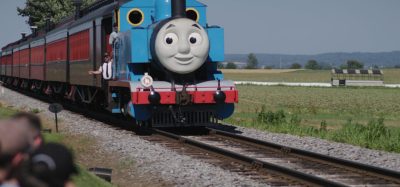Condition detection – an intelligent solution
Posted: 28 July 2006 | | No comments yet
In view of free network access, it is important for railway companies to detect the condition (loading, driving stability, out-of-roundness of wheels) of their trains as they run along the track. In 1998, the Austrian Federal Railways (ÖBB) began research in the field of intelligent local measurement. The ARGOS system covers this entire field of application. The main goal of local ARGOS checkpoints is to detect the dynamic condition of the trains travelling on the track at operating speeds with the highest accuracy and reliability.
In view of free network access, it is important for railway companies to detect the condition (loading, driving stability, out-of-roundness of wheels) of their trains as they run along the track. In 1998, the Austrian Federal Railways (ÖBB) began research in the field of intelligent local measurement. The ARGOS system covers this entire field of application. The main goal of local ARGOS checkpoints is to detect the dynamic condition of the trains travelling on the track at operating speeds with the highest accuracy and reliability.
In view of free network access, it is important for railway companies to detect the condition (loading, driving stability, out-of-roundness of wheels) of their trains as they run along the track.
In 1998, the Austrian Federal Railways (ÖBB) began research in the field of intelligent local measurement. The ARGOS system covers this entire field of application. The main goal of local ARGOS checkpoints is to detect the dynamic condition of the trains travelling on the track at operating speeds with the highest accuracy and reliability.
Today in the liberalised European railway market, every rolling stock operator is allowed to use national and local railway networks. The infrastructure owner has to trust that the rolling stock of the railway companies are in good running condition and that the declared loads are accurate. However, the railway company and the infrastructure owner have contrary interests. The railway operator wants to transport as much as possible using inexpensive rolling stock. However, cheap rolling stock frequently has inferior running characteristics. The infrastructure owner wants to charge for every transported load. And, loads should be transported in ‘rail-friendly’ wagons which generate little noise, low forces on the track, minimal wear, and have no risk of derailment. Furthermore, the infrastructure owner has many customers who use his railway network and he has to charge fairly for every single train depending on its use of the network.
These duties and responsibilities can only be fulfilled economically through the use of automatically operating measurement stations.
ARGOS local measurement stations
The ARGOS local measurement points enable the continuous monitoring of vehicle status and superstructure load parameters and ensure a constant quality level. ARGOS is designed to deliver a high level of measurement accuracy and reliability to provide legally secure proof of the measured values. The measurement equipment and the measurement process do not impede normal traffic. The rolling stock does not need to be fitted with any additional equipment. Due to the high volume of international rolling stock used for freight it is not possible to equip them all with a monitoring device. The only viable economic alternative was a rail network monitoring system. Nevertheless, vehicle identification systems like transponders can be incorporated.
ARGOS local measuring points do not require any specific maintenance measures. Track sections equipped with ARGOS can be tamped, ground and re-profiled as with the rest of the track.
There are three types of ARGOS systems depending on usage:
- Level 1: On-track derailment detection
- Level 2: Automatic train monitoring (Q-force, wheel defects)
- Level 3: Measurement of derailment safety (Q and Y-force, running behaviour, noise)
Level 1: Derailment detection
In the past, accidents could have occurred where single axles derailed and ran outside the rail over long distances. At upcoming risk points like tunnels, bridges, switches, etc. the whole train could have possibly derailed and a serious accident could have happened. Even if it would not have lead to a serious incident, long distances of the track could have been damaged by the derailed wheels. If this would have taken place on slap track sections the subsequent financial loss would have been significant due to the difficult reconstruction. For the locomotive driver it would have not been possible to notice single derailed axles. Therefore, a technical monitoring solution – such as the ARGOS systems offer – is necessary in risk-prone sections of the track.
The ARGOS Level 1 system can detect rolling stock which has already derailed and gave an output to the signalling system. The exceptional advantage of the ARGOS Level 1 system comes from its ability to monitor the whole area between the rails. This means that a derailment will even be detected in cases when the wheel is running narrowly over the screws and clamps of the rail. It consists of a set of four sensors in series, attached to the sleepers, to also detect jumping derailed wheels (a problem at high speeds). Extensive tests have shown that the system operates at speeds up to 300km/h and above.
Like all ARGOS levels, this system is also very maintenance friendly. All rail fastening elements are visible and serviceable without having to dismount the Level 1 sensor. Damping is also possible without removal of the sensor. Level 1 can be mounted on wood, concrete and steel sleepers as well as on slap track.
The Level 1 sensor consists of industrially proven force transducers, covered with a special metal plate. Through its simple and rugged construction and the logical interconnection of all four sensor elements there is no risk of an erroneous alarm.
ARGOS Level 1 is a simple, cost-effective system which enables comprehensive safety on risk-prone sections of the railway network.
Level 2: ARGOS Q, wheel defects
With ARGOS Level 2 it is possible to detect irregularities in rolling stock by monitoring the vertical wheel forces (quasi-static and dynamic forces) and wheel defects. The use of reliable sensors in rail monitoring takes the strain off company personnel, e.g. station masters and train inspectors. Vehicle control can be carried out selectively.
Level 3: ARGOS Y/Q
In addition to Level 2, Level 3 also measures the horizontal forces. The forces are measured as continuous dynamic lateral wheel force and continuous wheel load. Derailments can be prevented through early detection of irregularities in rolling stock, and by measuring the wheel forces and the wheel geometry.
Like measurement Level 2, Level 3 measurement stations provide very good long-term accuracy, and deliver measurement results within 120 seconds.. They require no foundations and do not impede the maintenance of the track.
Level 3a: Y/Q in curves
ARGOS Level 3a is a comprehensive solution for curves. It provides reliable risk detection and cost factors of derailments on Y and Q force overload, derailment factors, load status, train composition, compliance with curves (positioning behaviour of wheels), running forces of the bogie and tilt resistance of the vehicle. Due to the high accuracy, Level 3a can also be used for homologation testing of vehicles.
Level 3b: Y/Q straight line
ARGOS Level 3b is mainly used for detection of instable running vehicles (e.g. hunting) in straight lines. The Y-force is continuously measured over a distance of around 45m. This allows a classification of the running behaviour and noise emission. Usually freight wagons have problems with noise emission and running behaviour. Like Levels 2 and 3a, Level 3b measures the Q and Y forces, the load status, the train composition and wheel defects.
Accuracy
ARGOS Level 2 and 3 are designed to supply a high level of measurement precision and reliability to provide legally secure proof of the measured values. The higher the accuracy of the measured value the easier it is to get practical acceptance from the vehicle operator and from homologation bodies.
The measured values are mostly used to determine exceeded limits. The graph above shows the basic problem with this. Only if the measured value +/- the tolerance class of the instrument is above or under the allowed tolerance range of the threshold, the measured value is definite (case 3 and 4). In cases 1 and 2 it is not possible to say anything about exceeding of permitted tolerances.
Only if the tolerance of the measuring instrument is at least three times better than the allowed tolerance of the threshold, it is possible to make statements inside the permissible tolerance band. This means that if you have a technical tolerance of 3%, your measurement system has an accuracy of 2% or more. In such a case the measurement system is worthless. For a technical tolerance of 3% your measurement instrument needs an accuracy of at least 1%.
ARGOS also detects wheel-shape irregularities with a high accuracy. All types of deviations are classified (flats, eccentricity, ovality, flattenings, polygons, etc.) and quantified. There is also a possibility to display the measured variance from the ideal wheel roundness over the whole wheel outline, see Fig.7.
Conclusion
ARGOS Level 1 is the perfect system for monitoring risk-prone sections of the track network to limit damage through derailed rolling stock.
ARGOS Level 2 and 3 can prevent accidents and deliver data about the rail/wheel interaction with a high level of accuracy. The life cycle cost of the infrastructure will progressively increase if the strain caused by rolling stock does not correspond with the overall load estimates for construction. Wheel flats, for example, increase maintenance costs by up to 20%. The same is applicable for axle loads that exceed set limiting values. The ARGOS Level 2 and Level 3 can also act as control points for track operators; they can be the basis for maintenance requirements and can be used to check invoiced services. ARGOS local measurement points also supply basic data for track usage fees. Irregularities and wheel shape defects are the main reason for noise emission and ground vibration. With ARGOS it is possible to continuously enhance ride quality. This leads to a substantial reduction of these emissions at the source. ARGOS data can also be used for optimal maintenance strategies for rail vehicles. This makes it possible to identify damage to individual rolling stock, and register damage history (trend analysis), to ensure better maintenance planning. Especially in the freight wagon sector, maintenance costs can be optimized through the monitoring of load and technical status.
ARGOS Level 2 and 3 supply documentation in compliance with safety standards and can be used to support TSI spot controls. The reliability and accuracy of the ARGOS systems result in a comprehensive increase of safety levels, fair user charges and cost reduction for the network operators.






